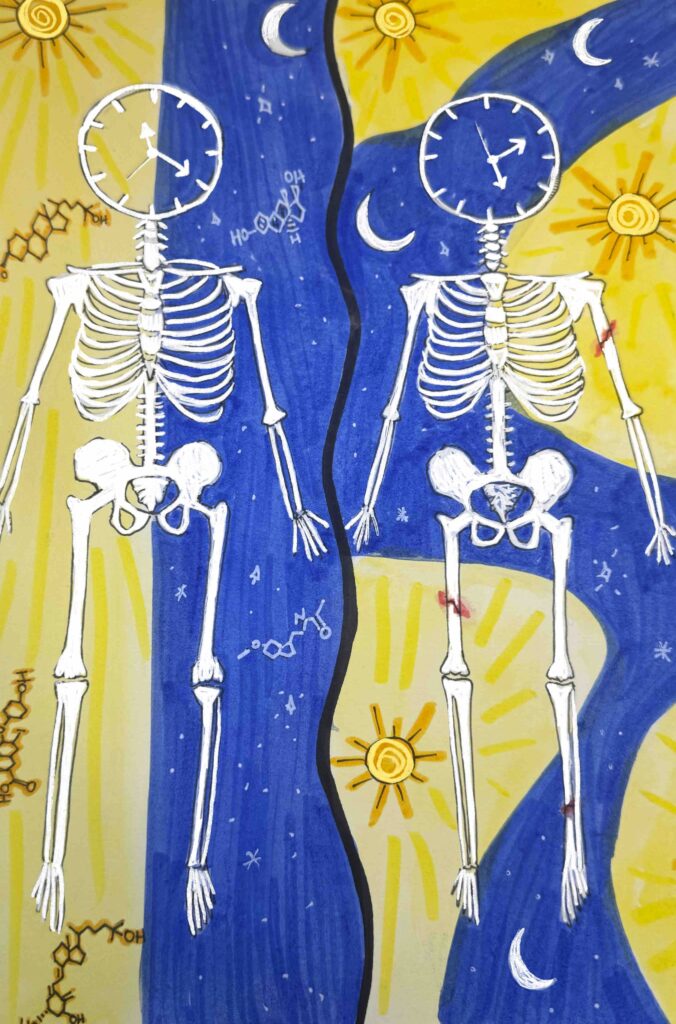
For my STEAM project, I chose to represent the relationship between sleep and bone health through a drawing. The project aims to address the course objectives related to the hormonal regulation of bone development and bone growth/repair. The drawing is of two skeletons each with a clock in place of the head. This symbolizes the circadian rhythm and sleep-wake cycle. The background is a mix between day (yellow) and night (blue). On the left, night and day are split in half, signifying a relatively normal circadian rhythm with sleep for an extended period at night. On the right, night and day are mixed up and in pieces illustrating sleeping in short bursts here and there, as may happen with shift work, insomnia, sleep apnea, etc. Surrounding the skeleton on the left, with a normal sleep schedule, are various chemical structures for hormones, demonstrating that a consistent sleep schedule with one long stretch of sleep is important for hormone levels. The skeleton on the right does not have hormones surrounding it but rather has fractures (marked red) across a few bones. This demonstrates that circadian/sleep disruptions lead to low bone mineral density (BMD) and increase the risk of fractures.
While I initially went into my research looking for connections directly related to sleep and bone health, I discovered that circadian rhythm as a whole plays more of a role. This is because the duration of sleep and timing affect hormones. Certain hormones peak at night, such as growth hormone, and others peak in the early morning, such as osteocalcin (Swanson et al. 2018). When sleep is interrupted or occurs at a time that does not align with usual circadian rhythms, the hormones may not peak as expected. An additional example of this is fibroblast growth factor, a protein secreted by osteocytes, that regulates phosphate metabolism and peaks each morning (Swanson et al. 2018).
In addition to being important for general bone health, circadian rhythm also affects the fracture healing process. An experiment done by Kunimoto et al. on mice found that administering medication at different times of day had different outcomes (Swanson et al. 2018). By timing medication correctly, scientists found that they could decrease intervals between peaks of certain hormones.
When bones break, there is initially a hematoma. Next, a fibrocartilaginous matrix creates the internal callus, and chondrocytes and osteoblasts create an external callus. These stabilize the inside and outside of the break. Then for a few weeks, osteoclasts resorb dead bone, while osteoblasts form from osteogenic cells (Betts et al., 2022, pg. 214). There is cartilage in the internal and external calli that slowly ossifies until healing is complete (Betts et al., 2022, pg. 214). Many factors influence fracture healing including age, diet, and fitness level. In terms of sleep and circadian rhythm, parathyroid hormone, important for the resorption of dead bone, peaks in the very early morning, while other hormones like osteocalcin for bone growth peak a bit later in the morning (Swanson et al. 2018). Having an irregular sleep schedule and poor circadian rhythm will therefore slow down fracture healing.
There is still a lot to learn about the relationship between sleep and bone health, but it is clear that having a poor sleep-wake cycle is related to low BMD and associated with a high rate of fractures (Kim et al. 2021). This is most likely related to hormones which peak at certain times of the day and are somewhat reliant upon circadian rhythm. Additionally, when the body is well-rested, all processes tend to work better. For general health, having a circadian rhythm is key.
Albert Kim, Michelle McDonald, Christian Girgis,The relationship between sleep and bone:Strange bedfellows?,Current Opinion in Endocrine and Metabolic Research,Volume 18, 2021,Pages 236-242,ISSN2451-9650,https://doi.org/10.1016/j.coemr.2021.04.003.(https://www.sciencedirect.com/science/article/pii/S245196502100051X)
Betts, J. G., Desaix, P., Johnson, E., Johnson, J. E., Korol, O., Kruse, D., Poe, B., Wise, J. A., Womble, M., & Young, K. A. (2022). Anatomy and physiology, 2E. OpenStax, Rice University.
Swanson, C. M., Kohrt, W. M., Buxton, O. M., Everson, C. A., Wright, K. P., Jr, Orwoll, E. S., & Shea, S. A. (2018). The importance of the circadian system & sleep for bone health. Metabolism: clinical and experimental, 84, 28–43. https://doi.org/10.1016/j.metabol.2017.12.002 https://pubmed.ncbi.nlm.nih.gov/29229227/

In progress photo

Hollin Priday represented the objective of hormonal regulations of bone health and repair. She decided to represent the objective through a drawing which depicts two skeletons with time clocks as skulls. The idea of the skulls being time clocks is to show that our sleep wake cycles affect our bone growth and repair. The picture shows that on one side there is a normal circadian rhythm which would mean bone growth and repair would be normal. The portrait also shows on the left side, that a normal sleep cycle is important for hormone regulation. The portrait also depicts a second skeleton that does not have a normal sleep and wake cycle so therefore has a lower bone mineral density, which can lead to fractures. In her description, she goes on to explain how certain hormones peak at night and how some peak in the morning. If these times are interrupted, then the hormones never peak, leading to irregular bone growth and repair. She also goes on to explain that circadian rhythm even plays a role in repairing broken bones. This would make sense because as she described before, circadian rhythm plays a role in bone growth and repair. She also explains that there are factors that affect bone healing after a break, such as age, diet, and fitness level.